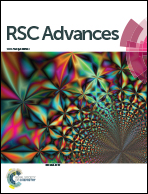A versatile ambient pressure drying approach to synthesize silica-based composite aerogels
Abstract
A versatile ambient pressure drying (APD) method for synthesizing silica aerogels, as well as silica-based composite aerogels with different colors or functions, has been developed in this work. The presented polyethoxydisiloxane (PEDS) was held under basic conditions in ethanol and alcogels were obtained, which was followed by hexane solvent-exchange and pore surface modification, and then the wet gels were dried under ambient pressure at temperatures ranging from 25 to 150 °C to produce silica aerogels with high BET surface areas and low thermal conductivities. Various guests were introduced, e.g., dyes, Fe3O4 nanoparticles and Ag nano-wires in the sol–gel process, and colored, magnetic or bio-functional silica aerogels were synthesized by the APD method. All the products were of high BET surface areas varying from 500 to 1000 m2 g−1 and of average pore sizes in the range of 8–20 nm, regardless of the drying temperature and the presence of dye molecules or embedded nano-particles. The tapping densities of the aerogels were in the range of 0.03 to 0.2 g cm−3, and the thermal conductivities were found varying from 0.022 to 0.040 W m−1 K−1. Moreover, the structures and morphologies of the aerogels were investigated by FTIR and SEM, respectively. The stability of the colored aerogels was studied by UV-vis spectrometry, and the results indicate that the dyes were embedded in the aerogels and may be gradually released. Furthermore, the capacity of the magnetic aerogels for wastewater treatment was investigated. In general, an APD method, involving a single hexane-exchange step, has been developed, and the preparation of various silica-based composite aerogels prepared by APD is achieved. This APD method shows a great potential to synthesize silica aerogels and its hybrid aerogels on an industrial scale.


 Please wait while we load your content...
Please wait while we load your content...